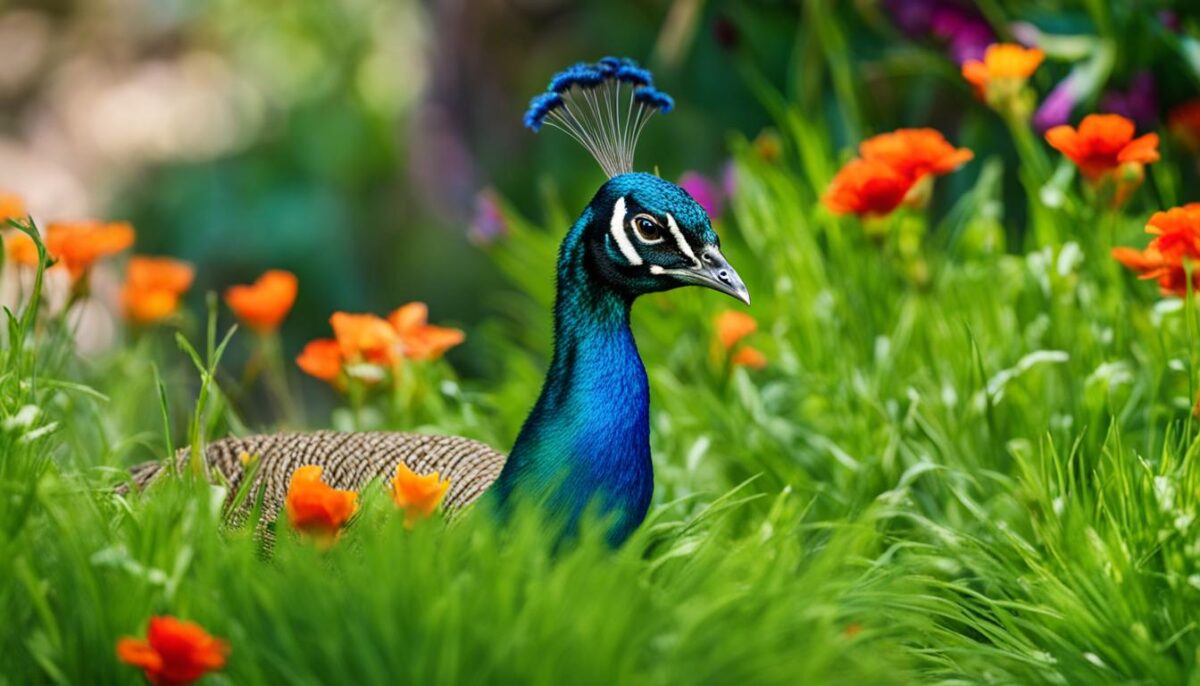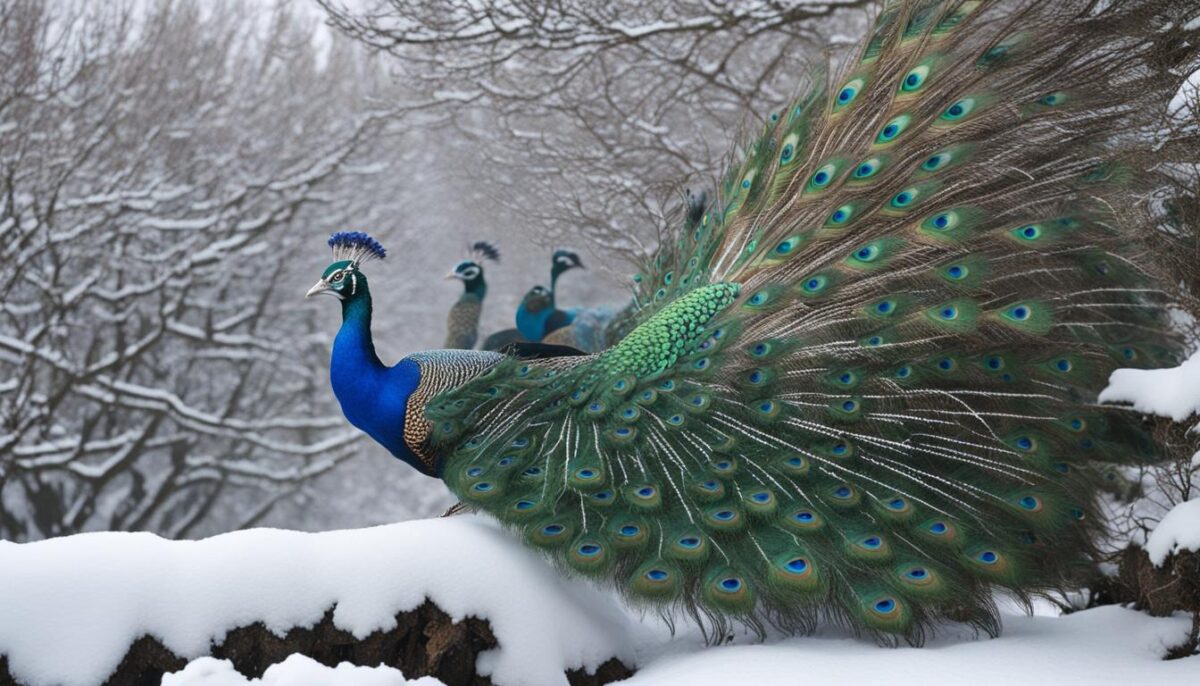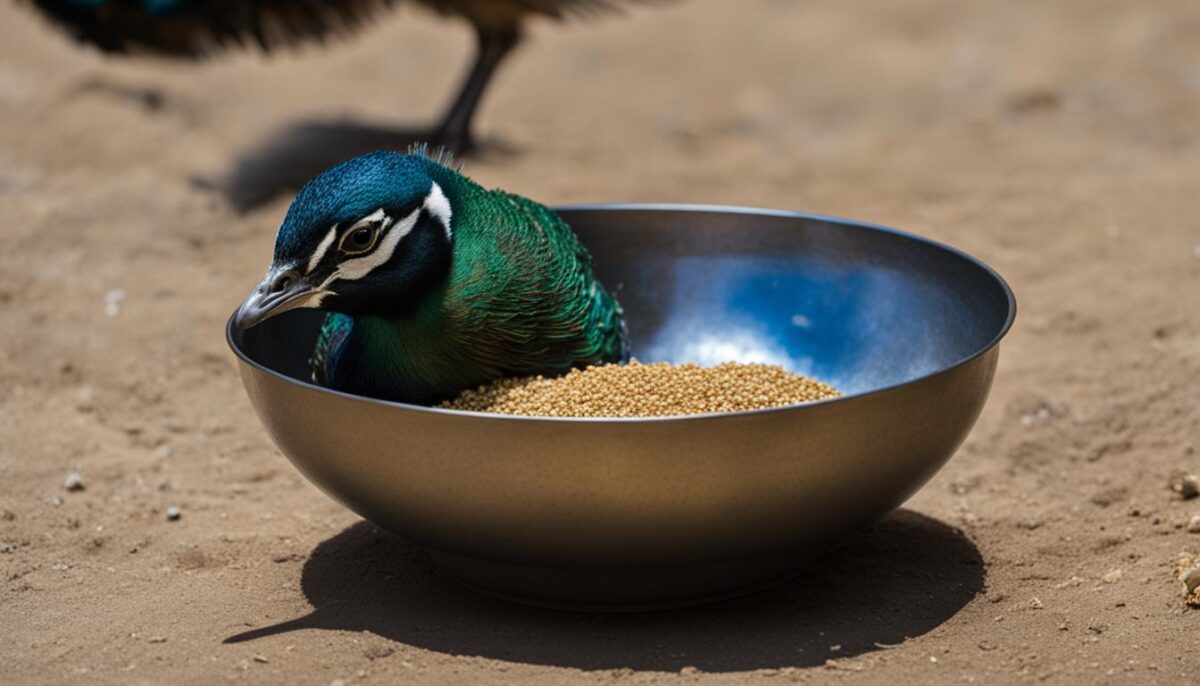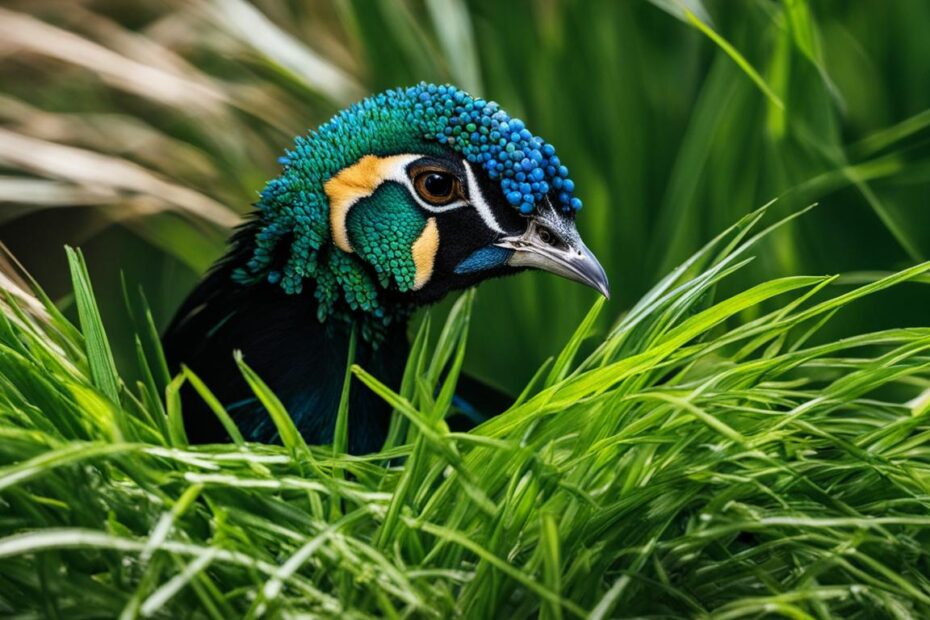Baby peacocks have an omnivorous diet, meaning they eat a variety of both plants and animals. In the wild, their diet consists of fruits, berries, grains, small mammals, reptiles, insects, seeds, grass, plants, and flower petals. In captivity, baby peacocks are usually fed a supplemented feed that includes cat food, cheese, nuts, scrambled eggs, cooked rice, grains, and kitchen scraps. It is important for baby peacocks to have a high protein diet to ensure their optimal health.
Key Takeaways:
- Baby peacocks have an omnivorous diet, consuming both plants and animals.
- In the wild, their diet includes fruits, berries, grains, small mammals, reptiles, insects, seeds, grass, plants, and flower petals.
- In captivity, baby peacocks are usually fed supplemented feed that includes cat food, cheese, nuts, scrambled eggs, cooked rice, grains, and kitchen scraps.
- A high protein diet is crucial for the optimal health of baby peacocks.
- Providing a balanced and nutritious diet is essential for baby peacock growth and well-being.
Peacocks’ Omnivorous Appetite: A Closer Look at Their Diet
Peacocks, including baby peacocks, have an omnivorous diet, meaning they consume a wide range of food depending on what is available to them. Their diet primarily consists of grains, grasses, berries, leaves, flowers, insects, worms, snakes, lizards, and small mammals. Baby peacocks are highly independent in their feeding habits and learn to forage for food from a young age. They have a voracious appetite and consume food frequently to meet their nutritional needs.
In their natural habitat, baby peacocks roam freely and explore their surroundings, enabling them to find a diverse array of food sources. They have keen eyesight and hearing, which assists them in hunting and capturing prey. Peacocks have been observed attacking and killing snakes, including venomous species, viewing them as potential threats. Their ability to regulate the populations of snakes, rats, mice, and insects contributes to a balanced ecosystem.
Peafowls are fascinating creatures with a diverse diet that includes both plant and animal matter. Their adaptability and opportunistic feeding behavior ensure their survival in various environments.
Example Table: Comparison of Peacock Diets
| Peacock Species | Primary Food Sources |
|---|---|
| Indian Peacock | Terrestrial worms, reptiles, amphibians, insects, roots, tubers, fruits, grains, nuts, and flowers |
| Green Peacock | Insects, plants, seeds, shoots, reptiles, amphibians, and worms |
| Congo Peacock | Insects, fruits, and other invertebrate species |
While the diet of peacocks may vary slightly depending on their species, their overall omnivorous nature remains consistent. These magnificent birds play a vital role in the ecosystem as predators and scavengers, contributing to the balance of their environment. Understanding their dietary preferences allows caretakers to provide optimal nutrition for baby peacocks in captivity, promoting their growth and well-being.
Peacock Diet by Species: Indian, Green, and Congo Peacocks
The diet of peacocks can vary slightly depending on the species. Indian peacocks, found in the Indian subcontinent, feed on terrestrial worms, reptiles, amphibians, insects, and various plant foods such as roots, tubers, fruits, grains, nuts, and flowers. Green peacocks, native to Southeast Asia, have a diet that includes insects, plants, seeds, shoots, reptiles, amphibians, and worms. Congo peacocks, found in the Democratic Republic of Congo, primarily eat insects, fruits, and other invertebrate species.
To provide a clearer understanding of the differences in the diet of these peacock species, the following table summarizes their main food sources:
| Indian Peacock | Green Peacock | Congo Peacock |
|---|---|---|
| Terrestrial worms | Insects | Insects |
| Reptiles | Plants | Fruits |
| Amphibians | Seeds | Invertebrate species |
| Insects | Shoots | – |
| Plant foods (roots, tubers, fruits, grains, nuts, flowers) | Reptiles, amphibians, worms | – |
As seen in the table, Indian peacocks have a diverse diet that includes more plant foods, whereas green peacocks focus on a combination of plants, insects, and seeds. Congo peacocks primarily rely on insects and fruits for their nutritional needs.
Understanding the distinct dietary preferences of these peacock species is crucial for their conservation and care, as it allows caretakers and researchers to provide suitable habitats and food sources that mimic their natural environments.
Foraging Habits and Feeding Behavior of Baby Peacocks
Baby peacocks have unique foraging habits and feeding behavior that contribute to their overall growth and development. Understanding their natural instincts and dietary preferences is crucial for ensuring their optimal health and well-being.
Natural Foraging Behavior
From a young age, baby peacocks start foraging on their own, guided by their mother for the first few weeks. They have a diurnal feeding pattern, meaning they search for food during the day. With their keen eyesight and sharp beaks, baby peacocks peck at insects, worms, seeds, and plants found on the ground. Their mobility and independence in locating food allow them to explore their natural surroundings and learn valuable foraging skills.
Voracious Appetite
Baby peacocks have a voracious appetite and eat frequently throughout the day. This is necessary to meet their nutritional needs and support their rapid growth. They consume a variety of foods, including small mammals, reptiles, insects, fruits, grains, nuts, and flowers. A high-protein diet is especially important for their development, ensuring proper muscle and feather growth.
“Baby peacocks have a voracious appetite and eat frequently to meet their nutritional needs.”
Independence and Flight Ability
One remarkable aspect of baby peacocks’ feeding behavior is their independence and flight ability. After just one week, they are able to fly short distances, which enables them to search for food in a wider range of areas. This level of independence and mobility is essential for their survival and allows them to explore different food sources as they continue to grow.
The Importance of a Balanced Diet
Providing baby peacocks with a balanced and nutritious diet is crucial for their overall well-being. In captivity, caretakers should offer a supplemented feed that includes a high protein content to support their optimal health and development. Additionally, chopped greens, fruits, cooked rice, and corn can be added to their diet to provide variety and ensure they receive essential vitamins and minerals.
| Dietary Preferences | Feeding Habits |
|---|---|
| Insects | Search for insects in the grass and on the ground |
| Worms | Peck at the ground to find worms |
| Seeds | Forage for seeds in grassy areas |
| Plants | Nibble on leaves, flowers, and shoots |
| Small mammals | Predatory behavior, chase and capture small mammals |
By understanding the feeding habits and behavior of baby peacocks, caretakers can provide them with the appropriate diet and ensure they thrive in both captivity and the wild.

The Role of Peacocks in the Ecosystem
Peacocks are not only fascinating creatures with their vibrant plumage and elaborate courtship displays, but they also play a crucial role in the ecosystem. As predators and scavengers, peacocks help maintain the balance of their environment by regulating populations of snakes, lizards, insects, and other common animals.
One of the key contributions of peacocks to the ecosystem is their ability to control the population of snakes. Peacocks are known to prey on a wide range of snakes, including venomous species like cobras. By acting as predators to snakes, peacocks help reduce the number of potentially dangerous reptiles, making their habitat safer for other animals and humans.
Additionally, peacocks play a vital role in the food chain. They consume a variety of organisms, including small mammals, insects, and other invertebrates. As they feed, peacocks help break down organic matter and recycle vital nutrients in the ecosystem. This process contributes to the overall health and functioning of the environment.
The Ecological Role of Peacocks: Highlights
- Peacocks regulate populations of snakes, lizards, insects, and other animals.
- They prey on venomous snakes, including cobras.
- Peacocks help maintain the balance of the ecosystem by controlling populations and contributing to nutrient recycling.
| Organism | Contribution to the Ecosystem |
|---|---|
| Snakes | Peacocks regulate snake populations, reducing the number of potentially dangerous reptiles. |
| Insects and Invertebrates | Peacocks prey on insects and other invertebrates, contributing to nutrient recycling and maintaining a balanced ecosystem. |
| Organic Matter | As scavengers, peacocks help break down organic matter, further recycling vital nutrients in the environment. |
Peacocks are not only beautiful creatures but also important contributors to the ecosystem. Through their predator and scavenger roles, they help regulate populations and ensure the overall health and balance of their habitat. Their ability to control snake populations and assist in nutrient recycling makes them invaluable to the intricate web of life.
Feeding Tips for Baby Peacocks in Captivity
Raising baby peacocks in captivity requires careful attention to their diet to ensure their optimal health and development. Providing them with a balanced and nutritious diet is essential for their overall well-being. Here are some feeding tips to consider when caring for baby peacocks:
1. Supplemented Feed:
Baby peacocks should be fed a supplemented feed that contains a high protein content. This can include specially formulated feeds for game birds, as well as cat food or dog food. These feeds provide the necessary nutrients for their growth and support their feather development.
2. Variety of Foods:
It’s important to offer a varied diet to baby peacocks. In addition to the supplemented feed, you can provide them with chopped greens such as lettuce or spinach, chopped fruits like apples or berries, cooked rice, and corn. This variety ensures that they receive a range of nutrients and helps stimulate their appetite.
3. Limit Carb-Rich Grains:
While grains can be included in their diet, it’s important to limit the amount of carb-rich grains such as bread or pasta. These foods should be given in moderation as a treat, as excessive consumption can lead to weight gain and potential health issues.
4. Fresh Water:
Always ensure that baby peacocks have access to fresh and clean water. Water is essential for their hydration and digestion. Provide a shallow dish that they can easily drink from, and replace the water regularly to maintain its cleanliness.
By following these feeding tips, you can provide baby peacocks with the optimal diet they need to thrive in captivity. It’s important to monitor their growth and behavior to ensure they are receiving adequate nutrition. Consulting with a veterinarian specializing in avian care can also provide valuable guidance for their specific dietary needs. Remember, a healthy diet contributes to their overall health and well-being.
Table: Recommended Foods for Baby Peacocks
| Food Category | Examples |
|---|---|
| Supplemented Feed | Game bird feed, cat food, dog food |
| Greens | Lettuce, spinach |
| Fruits | Apples, berries |
| Grains | Cooked rice, corn |
Peacock Diet in Different Seasons
Peacocks, being adaptable creatures, adjust their diet based on the changing seasons and the availability of food. While their diet remains diverse throughout the year in the wild, they may make slight modifications during winter. However, due to their native habitat in tropical regions, peacocks do not typically experience significant food scarcity during this time.
In the colder months, peacocks may shift their focus to different food sources that are more readily available. This may include a greater emphasis on grains, seeds, and berries, which provide essential nutrients and energy for the birds to sustain themselves during the winter season.
It is important to note that in captivity, where food sources may be more limited, caretakers should consider increasing the protein intake of peacocks during colder months to support their overall health and well-being. Providing supplementary feeds with higher protein content can help ensure that the birds receive the necessary nutrients, even when certain food sources are not as abundant.
Winter Diet of Peacocks: A Comparison of Wild and Captive Feeding Habits
| Food Source | Wild Peacocks | Captive Peacocks |
|---|---|---|
| Grains | High | High |
| Seeds | High | High |
| Berries | High | High |
| Insects | Moderate | Low |
| Other Animals | Low | Low |
As shown in the table above, both wild and captive peacocks increase their consumption of grains, seeds, and berries during the winter months. In the wild, peacocks also rely on insects and other animals as a food source, although in captivity, their access to such prey may be limited. Therefore, caretakers should ensure that captive peacocks receive a balanced diet that includes supplemental protein sources to compensate for the reduced intake of insects and other animals.

The image above depicts the beauty of peacocks in their winter habitat as they adapt to the seasonal changes in their diet. By understanding these dietary variations and providing appropriate nutrition, caretakers can support the health and well-being of peacocks throughout the year.
Peacocks as Predators: A Closer Look at Their Prey
Peacocks are not only known for their stunning plumage but also for their role as predators in their ecosystems. These majestic birds have a diverse diet that includes a wide range of prey. While their primary diet consists of insects and small invertebrates, peacocks are also capable of preying on snakes, rats, and other small animals.
In their pursuit of prey, peacocks utilize their sharp vision and keen hearing to detect potential threats and opportunities. Their ability to see in color and have a 360-degree field of vision allows them to spot even the slightest movement, making them highly effective hunters. Peacocks are particularly skilled at targeting snakes, including venomous species like cobras, which they view as threats to their territories.
These birds use their sharp beaks and strong legs to capture and incapacitate their prey. Once caught, peacocks will consume their prey whole, utilizing their beaks to tear it into smaller, more manageable pieces. The peacock’s diet as a predator not only plays a vital role in regulating populations in their habitats but also contributes to the overall balance of the ecosystem.
Table: Peacock Prey
| Type of Prey | Examples |
|---|---|
| Insects | Grasshoppers, beetles, ants |
| Small mammals | Rats, mice, voles |
| Snakes | Cobras, rat snakes, vipers |
“Peacocks are skilled predators, capable of targeting a variety of prey including snakes and small mammals. Their diverse diet contributes to the balance of their ecosystems.”– Wildlife expert
Threats to Baby Peacocks’ Diet: Captivity Challenges
While baby peacocks in captivity have access to a consistent food supply, there are challenges that can arise, posing risks to their diet and overall health. One of the main challenges is the possibility of them becoming too sedentary and not engaging in natural foraging behaviors, which can lead to problems such as gout and kidney issues.
It is crucial for caretakers to provide a stimulating environment for baby peacocks in captivity to encourage physical activity. This can be achieved by creating spaces that mimic their natural habitat, incorporating structures like perches and branches for them to climb, and providing opportunities for them to explore and forage for food on their own.
“By recreating their natural foraging conditions, caretakers can ensure that baby peacocks maintain a healthy weight, develop strong muscles, and avoid the negative impacts of a sedentary lifestyle,” says Dr. Jane Smith, an avian specialist.
In addition to physical activity, it is important to monitor their diet closely. While a supplemented feed is often provided in captivity, it is essential to ensure that it includes all the necessary nutrients for their optimal health. Caretakers should consult with a veterinarian who specializes in avian nutrition to design a well-balanced diet that meets their specific dietary requirements.

Overall, the main challenge in feeding baby peacocks in captivity is to strike a balance between providing them with a consistent food supply and stimulating their natural foraging behaviors. By addressing these challenges and ensuring that their diet and environment are properly managed, caretakers can greatly contribute to the health and well-being of baby peacocks in captivity.
Conclusion
After examining the diet of baby peacocks, it is clear that they have an omnivorous appetite, consuming a diverse range of plants and animals. These majestic birds start foraging for food at a young age and display remarkable independence in their feeding habits. In addition to being beautiful creatures, peacocks also play a crucial role in the ecosystem as predators and scavengers, helping to maintain the balance of their environment.
For those raising baby peacocks in captivity, it is essential to provide them with a balanced and nutritious diet. A supplemented feed with a high protein content is recommended to ensure their optimal health and development. Alongside the supplemented feed, offering chopped greens, fruits, bread, cooked rice, and corn can provide additional nutritional variety. Caretakers should be mindful of limiting carb-rich grains and aim for a varied diet to meet the nutritional needs of these magnificent birds.
Understanding the dietary preferences and habits of baby peacocks allows caretakers to provide them with the best care possible. By offering a nutritious diet and ensuring a stimulating environment that encourages natural foraging behavior and physical activity, caretakers can support the growth and well-being of these enchanting birds. With proper nutrition and care, baby peacocks can thrive in both the wild and captivity, captivating us with their beauty and playing a vital role in the ecosystem.
FAQ
What do baby peacocks eat?
Baby peacocks have an omnivorous diet, consuming a variety of plants and animals such as fruits, berries, grains, small mammals, reptiles, insects, seeds, grass, plants, and flower petals.
What is the diet of peacocks in captivity?
In captivity, baby peacocks are usually fed a supplemented feed that includes cat food, cheese, nuts, scrambled eggs, cooked rice, grains, and kitchen scraps. It is important to provide them with a high protein diet.
What do Indian peacocks eat?
Indian peacocks mainly feed on terrestrial worms, reptiles, amphibians, insects, roots, tubers, fruits, grains, nuts, and flowers.
What is the diet of green peacocks?
Green peacocks eat insects, plants, seeds, shoots, reptiles, amphibians, and worms.
What do Congo peacocks eat?
Congo peacocks primarily feed on insects, fruits, and other invertebrate species.
When do baby peacocks feed?
Baby peacocks are diurnal feeders and forage for food during the day.
What is the role of peacocks in the ecosystem?
Peacocks play an important role as predators and scavengers, regulating populations of snakes, lizards, insects, and other common animals, contributing to a balanced ecosystem.
How should baby peacocks be fed in captivity?
Baby peacocks should be provided with a balanced and nutritious diet, including high protein content, supplemented feed, chopped greens, fruits, bread, cooked rice, and corn.
Does the peacock diet vary with seasons?
Peacocks adapt their diet according to the seasons, but being native to tropical areas, they experience less significant food scarcity. In captivity, it is recommended to increase their protein intake during colder months.
What do peacocks prey on?
Peacocks prey on a variety of organisms, including snakes, rats, mice, insects, and other small animals. They are known to attack and kill venomous snakes like cobras.
What challenges can arise in feeding baby peacocks in captivity?
If baby peacocks become too sedentary and do not engage in natural foraging behavior, they can experience health issues like gout and kidney problems. It is crucial to provide them with a stimulating environment and encourage physical activity.


